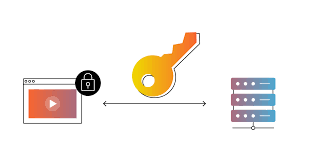With the digital streaming market, the entire consumption of entertainment contents has changed drastically. As the video streaming industry is constantly on the rise, huge heights are expected to be achieved on the global level; therefore, services of this sort providing access on a subscription basis have become the keystone of contemporary entertainment delivery. But there are major challenges posed by this digital revolution especially when it comes to securing the value of the content against piracy and illegal dissemination. This is when the video DRM (Digital Rights Management) technology comes to the scene as a truly irreplaceable protector of the digital assets, as it allows the content owners and streaming services to keep their intellectual property intact and at the same time offer their customers undisrupted streaming of the content with the methods of the roadblocks of the illegal users.
Understanding the Modern Streaming Ecosystem
Their subscription based streaming model has transformed the entertainment market since it provides customers with access to huge contents libraries at a relatively low monthly payment amount. Netflix, Amazon prime video, Disney plus, and other companies have made their business model on the idea of exclusive, high-quality content coming straight to the devices of viewers. This ecosystem is very keen on the trust of the subscribers and perceived value of premium and unreachable content.
The streaming contents however are by their very nature susceptible to piracy because they are digitally encoded. Digital video files can be copied an infinite number of times, and the quality will remain the same, unlike with physical media, which makes them appealing targets to pirates and other unauthorized redistributors. The economic effects of content piracy go much beyond direct revenue loss which included the acquisition of new subscribers, content licensing deals and viability of the subscription based service as a whole.
The Critical Role of Video DRM in Content Protection
The first arm in the war on content piracy is video DRM software that applies advanced encryption and access management capabilities. Such systems are characterized as video contents being encrypted as they are stored and transmitted so that only approved devices that possess the right decryption keys can make contents viewable. The technology develops a secure pipe between content servers and end-user devices, keeping it safe all the way up the chain of distribution.
The current generation video DRM systems use several strata of protection such as device authorization, license protection, and real-time control of an access behavior. It is a multi-layered security system which means that although one type of security is breached, there are other security barriers left intact to stop the unwanted traffic. It is also a technology that allows the content provider to enforce flexible viewing policy like capping of the number of simultaneous streams, putting an expiry time on the downloaded material as well as geographical blocking on the content.
The advantages of video DRM are not limited to the question of easy piracy. It allows streaming providers to provide tiered service levels, secure exclusivity of premium content as well as meet the requirements of content licensing agreements. The absence of effective DRM protection would make subscription services very difficult to obtain high-value content because studios and distributors insist on anti-piracy policies as a condition of supplying the content.
Financial Impact and Business Implications
The economic ramifications of poor video DRM protection may spell disaster to subscription-based operations. Pirating of content does not just lead to revenue loss due to decrease in number of subscribers but also removes the basic value point that drives the subscription method. When high-quality content is available to all for free via pirate sites, the desire of all the necessarily potential customers to pay money to gain legitimate access to these materials can hardly occur, and the vicious circle of losses in all business in it is poured.
In addition to direct economic effects, poor content protection may also hurt relations with the content creators/distributors. Most big studios and producers of content spend billions of dollars creating top-notch entertainment, and they want distribution partners in place to have solid security practices in place because they want them to protect their investments. Those streaming platforms which cannot ensure sufficient protection can simply be excluded in the licensing deals of high-value types of content, which essentially reverses their competitive advantage in the marketplace.
Security breaches may also create long term effects on the subscriber acquisition and retention due to reputational harm. The consumers who spend their money on the subscription services anticipate exclusive access to high quality and content of the programs they are on. When this content is easy to access due to piracy, subscribers might raise concerns about the worth of what they pay monthly and might drop the subscriptions.
Technical Challenges and Solutions
The Role of DRM in video: To use video DRM effectively, it is necessary to overcome, on the one hand, dozens of technical challenges and, on the other one, to provide the maximum user experience. The new streaming theatres need to provide playback on a variety of devices, operating systems and network scenarios at a maintained level of security. The complexity requires some advanced DRM solutions that will be capable of changing themselves to different technical specifications without altering security or performance.
It is this international aspect of streaming services that makes the challenge all the more byzantine. The content should be shielded in passing through various global networks, government regulations, and network infrastructures. Video DRM systems have a high degree of variation in the types of environment that they are required to operate in whilst still needing to be sufficiently flexible in order to support various regional specifications and device capabilities.
Conclusion
In this severe security environment firms such as Doverunner are offering imperative multi-DRM solutions that encrypt and scrounge video content using propitious encryption and access control procedures. Such specialized providers help ensure that the ecosystem of entertainment subscriptions is sustainable and can continue to grow as they assist the people who do the work of creating content and streaming platforms to protect against piracy and unauthorized access. Sophisticated video DRM protection is going to play an increasingly central role in helping the streaming industry strike the fragile balance between accessibility and security that makes a good digital entertainment platform.




